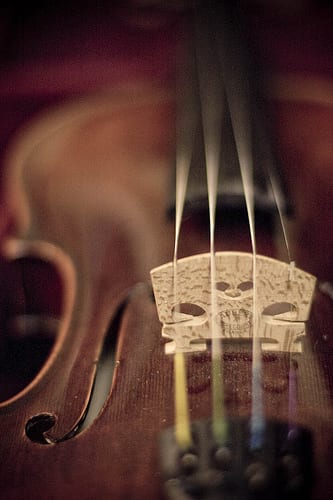 For beginner violinists, that mysterious lump of tree sap in your instrument case might seem a little strange. But that sticky substance – rosin – is actually essential to creating a beautiful, even tone.
For beginner violinists, that mysterious lump of tree sap in your instrument case might seem a little strange. But that sticky substance – rosin – is actually essential to creating a beautiful, even tone.
Particularly if you’ve just purchased a new violin bow, it’s important to learn how to apply rosin properly before you begin playing your violin. The rosin makes the hairs on the bow “sticky,” allowing them to grip the string and produce a good tone.
First, when applying the rosin, make sure you’re covering the strings with an even coat. If you end up with too little rosin, your bow may not have enough grip. Apply too much, and you may end up with a squeaky tone (and rosin dust everywhere!).
Read on for additional advice from the pros at Kennedy Violins:
After you’ve applied rosin to the bow for the first time, a lot of rosin dust will probably go all over your violin when you first start to play. Don’t be alarmed by this. You can simply wipe it off with a soft cotton cloth after you’re done with the initial rosining of your new bow. The next step is to play the violin for a little while to work the rosin into the new bow hair. Once you’ve done this, reapply a little bit of rosin to the bow (perhaps 3-6 passes) and play the violin some more. If you do it right, you’ll have a new bow that plays without creating excessive rosin dust. If you are habitual about wiping down your bow and violin every time you play, your violin will stay looking new for a very long time.
When your bow gets to the point where you have to put more force on it than you like to create the amount of sound you want, it is time to apply more rosin. You’ll probably only have to go up and down the bow 3 or 4 times to get the correct amount of rosin on the bow. In most situations, you’ll only have to rosin the bow per 3-5 hours of play time. People with stringed instruments that have thicker gauge strings like basses, cellos and even violas will probably end up rosining their bows a little more frequently than violinists. It is not uncommon for a violinist to apply rosin every 6 hours or so of playing, but it really depends on personal preference.
Continue reading the article here.
Of course, your violin teacher can help you learn the correct way of applying rosin, as learning when and how to use it will make a big difference in your playing – and with proper use, your bow and strings will thank you!
Suzy S.
